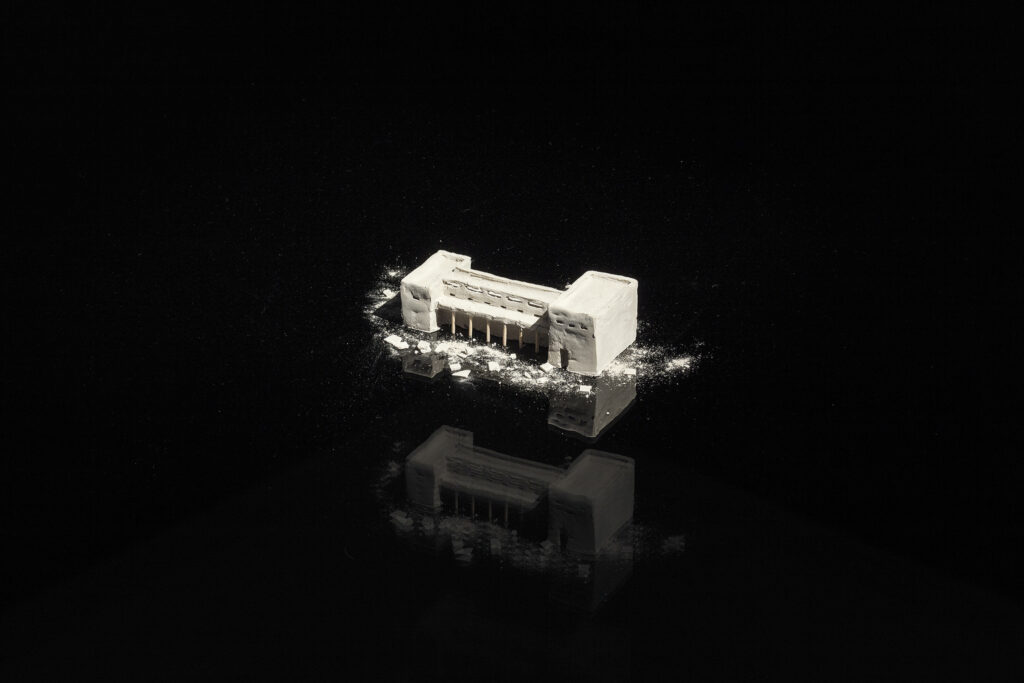
Taavi Talve (1970) is a Tallinn-based artist. His recent 16 mm analogue films are based on research stemming from a desire to connect events of the past to the present and with the artist himself. In his work, observations blend fact and fiction, and simultaneously take on a documentary and an imaginative approach.
Talve entered the Estonian art scene in 2005 as a member of the group Johnson & Johnson (with Indrek Köster). Together they made short films, videos, spatial installations, sculptures, objects, and site specific installations. Their work relies on neo-conceptual institutional and media critique, as well as a leftist resistance to market capitalism. One of the best known projects by J & J is the “Paldiski Project” (2006–2013), which involved a large part of the inhabitants of the city of Paldiski; discussing what kind of a sculpture should be created to commemorate Amandus Adamson, one of the best known sculptors in Estonia, in his home town. As Adamson was seen as a father figure for various communities of the city, the project aimed to set in motion a democratic process of decision-making in a city with a complicated history, as well as to propose a model of cooperation between the Estonian and Russian speaking communities. In 2013 a replica of Adamson’s sculpture “Last Sigh of a Ship” (1899) was installed at the heart of Paldiski, however, only a month later, it was removed by the city authorities, and after a few years, due to a local initiative, it found a new home on the Pakri peninsula near Paldiski.
Talve’s other collaborative projects and earlier work is characterised by a focus on the failure of articulation and self-expression, referencing, and a laconic visual language. His earlier works display elements of social criticism aimed at the political discourse of the newly independent Estonia, where market capitalism and nationalism intertwine. For example, Talve’s first solo exhibition “Bookmarks” (2010, Hobusepea gallery) linked Margaret Thatcher’s 1975 speech “Free Society”, Estonian song festivals, the neoliberal economic and social model, the economic crisis, political activism, and riots.
Talve’s later works focus on archiving and connecting past and present events; here the artist acts as an agent conserving memories, presenting subjective interpretations and new imaginaries. In 2016 Talve exhibited at the show “Between Archive and Architecture. Neeme Külm, Krista Mölder, Taavi Talve” at the Kumu Art Museum (curated by Kati Ilves, 2016/2017), screening his film “Blind Spot” (2016). It tells the story of Epp Kotkas, who lived and worked in New York in the 1970s, mainly together with the American choreographer and film maker Yvonne Rainer. The artist began tracking Kotkas down after noticing her name in the closing credits of Rainer’s 1972 film “Lives of Performers”. This resulted in a collage of photos, snapshots, articles, snippets of biographical information, taken as an obsessive excuse to resurrect an archive, and create a personal connection to a lost history. “Blind Spot”, consisting of a video and crime novel like installation, shows Epp Kotkas more as an object of obsessive fiction rather than a real person.
As a filmmaker, Talve re-films press photographs of historic events and archival materials, thus creating a spatial and dynamic collage. In the 2018 Köler Prize exhibition he presented the installation “The World to Come” (2018), based on the terrorist attack at the Olympic Games in Munich, using media coverage and memories from that time as source material.
In 2020 Talve’s solo exhibition “Documented Points of View” at the Monumental Gallery of the Tartu Art House discussed the relationship between landscape and memory. The show was inspired by various points of view that frame landscapes, travelogues from different eras, and journal entries from various authors. The narrative was created as first-person entries, tying together different eras, events, and people.
Taavi Talve studied sculpture at the Estonian Academy of Arts (1993–1997) and fine art (MA, 2005–2008). Since 2005 Talve has been part of the group Johnson & Johnson (with Indrek Köster) and in 2013 the duo received the Annual Award of the Estonian Cultural Endowment. Talve has been nominated for the Köler Prize twice: in 2012 (as Johnson & Johnson) and in 2018. His works belong to the collections of Tartu Art Museum, Art Museum of Estonia and the Ludwig Museum in Budapest. He is the head of the sculpture and installation department at the Estonian Academy of Arts.